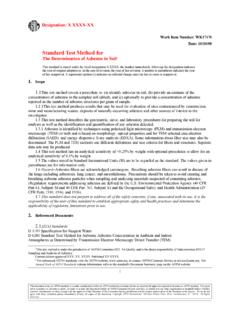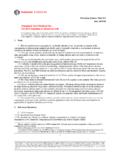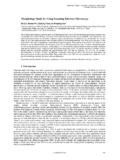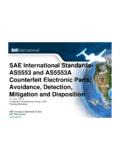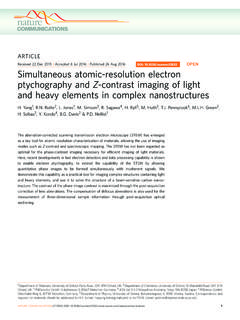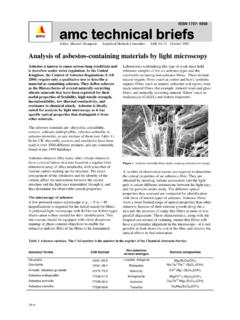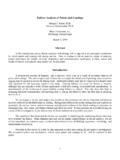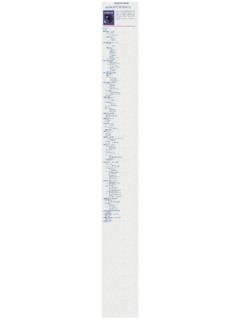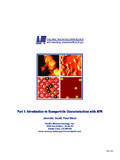Transcription of Bulk materials — — Part 1: Sampling and qualitative ...
1 ISO 2007 All rights reserved Document type: International Standard Document subtype: Document stage: (40) Enquiry Document language: E C:\MyFiles\ISO\ISO_Bulk_DIS\ISO DIS 2007\ISO_22262-1_(E) STD Version ISO TC 146/SC 3 Date: 2007-09-18 ISO/DIS 22262-1 ISO TC 146/SC 3/WG 1 Secretariat: ANSI Bulk materials Part 1: Sampling and qualitative determination of asbestos in commercial bulk materials l ment introductif l ment central Partie 1: Titre de la partie Warning This document is not an ISO International Standard. It is distributed for review and comment. It is subject to change without notice and may not be referred to as an International Standard. Recipients of this draft are invited to submit, with their comments, notification of any relevant patent rights of which they are aware and to provide supporting documentation.
2 Copyright notice This ISO document is a Draft International Standard and is copyright-protected by ISO. Except as permitted under the applicable laws of the user's country, neither this ISO draft nor any extract from it may be reproduced, stored in a retrieval system or transmitted in any form or by any means, electronic, photocopying, recording or otherwise, without prior written permission being secured. Requests for permission to reproduce should be addressed to either ISO at the address below or ISO's member body in the country of the requester. ISO copyright office Case postale 56 CH-1211 Geneva 20 Tel. + 41 22 749 01 11 Fax + 41 22 749 09 47 E-mail Web Reproduction may be subject to royalty payments or a licensing agreement.
3 Violators may be ISO 2007 All rights reserved Contents Page 1 Scope ..1 General ..1 Substance determined ..1 Type of sample ..1 Range ..2 Limit of detection ..2 2 Normative references ..2 3 Principle ..2 4 Terms and definitions ..2 5 Symbols and abbreviated terms ..6 6 Sample collection ..6 Requirements ..6 Sampling apparatus ..6 HEPA vacuum cleaner ..7 materials and supplies for Sampling ..7 Procedure ..8 Safety precautions ..8 Sample size requirements ..8 7 Sample preparation .. 11 General .. 11 Removal of organic materials by ashing .. 11 Removal of soluble constituents by acid treatment .. 11 Sedimentation and flotation .. 11 Combination of gravimetric reduction procedures.
4 11 8 Analysis by PLM .. 11 Requirements .. 11 Stereo-binocular microscope .. 11 Polarized light microscope .. 11 Dust extract hood .. 12 Sample preparation .. 12 qualitative analysis by PLM .. 15 Calibration .. 15 Sample preparation .. 16 Sample analysis .. 16 Interferences .. 23 9 Analysis by SEM .. 25 Requirements .. 25 Scanning electron microscope .. 25 Energy dispersive x-ray system .. 25 Vacuum coating unit .. 25 Calibration .. 25 Sample preparation .. 26 qualitative analysis by SEM .. 26 Sample analysis .. 26 10 Analysis by TEM .. 28 Requirements .. 28 Transmission electron microscope .. 28 Energy dispersive X-ray analyzer .. 28 Vacuum coating unit .. 28 Calibration grids for EDXA.
5 28 Disposable tip micropipettes .. 28 Calibration .. 28 ISO 2007 All rights reserved 3 Sample 29 qualitative analysis by TEM .. 29 Chrysotile .. 29 Amosite .. 29 Crocidolite .. 29 Tremolite .. 29 Actinolite .. 30 Anthophyllite .. 30 Sodic-calcic amphibole asbestos (richterite/winchite) .. 30 11 Test report .. 30 Annex A (normative) Types of commercial asbestos-containing material .. 33 Annex B (normative) Interference colour chart .. 40 Annex C (normative) Dispersion staining charts .. 41 Annex D (normative) Identification of asbestos by PLM and dispersion staining in commercial asbestos-containing materials .. 44 Annex E (normative) Identification of asbestos by SEM in commercial asbestos-containing materials .
6 53 Annex F (normative) Identification of asbestos by TEM in commercial asbestos-containing materials .. 59 Annex G (informative) Example of Sampling record .. 65 Annex H (informative) Example of analysis report .. 66 4 ISO 2007 All rights reserved Foreword ISO (the International Organization for Standardization) is a worldwide federation of national standards bodies (ISO member bodies). The work of preparing International Standards is normally carried out through ISO technical committees. Each member body interested in a subject for which a technical committee has been established has the right to be represented on that committee. International organizations, governmental and non-governmental, in liaison with ISO, also take part in the work.
7 ISO collaborates closely with the International Electrotechnical Commission (IEC) on all matters of electrotechnical standardization. International Standards are drafted in accordance with the rules given in the ISO/IEC Directives, Part 2. The main task of technical committees is to prepare International Standards. Draft International Standards adopted by the technical committees are circulated to the member bodies for voting. Publication as an International Standard requires approval by at least 75 % of the member bodies casting a vote. Attention is drawn to the possibility that some of the elements of this document may be the subject of patent rights. ISO shall not be held responsible for identifying any or all such patent rights.
8 ISO 22262-1 was prepared by Technical Committee ISO/TC 146, Air quality, Subcommittee SC 3, Ambient air. This second/third/.. edition cancels and replaces the first/second/.. edition (), [clause(s) / subclause(s) / table(s) / figure(s) / annex(es)] of which [has / have] been technically revised. ISO 22262 consists of the following parts, under the general title Bulk materials : Part 1: Sampling and qualitative determination of asbestos in commercial bulk materials Part [n]: Part [n+1]: ISO 2007 All rights reserved 5 Introduction In the past, asbestos was used in a wide range of products. materials containing high proportions of asbestos were used in buildings and in industry for fireproofing, thermal insulation and acoustic insulation.
9 Asbestos was also used to reinforce materials , to improve fracture and bending characteristics. A large proportion of the asbestos produced was used in asbestos-cement products. These include flat sheets, tiles and corrugated sheets for roofing, pipes and open troughs for collection of rainwater, and pressure pipes for supply of potable water. Asbestos was also incorporated into products such as decorative coatings and plasters, glues, sealants and resins, floor tiles, gaskets and road paving. In some products asbestos was incorporated to modify rheological properties, for example in the manufacture of ceiling tile panels and oil drilling muds.
10 Three varieties of asbestos found extensive commercial application. Chrysotile accounted for approximately 95% of consumption, and therefore this is the variety that is encountered most frequently during analysis of samples. Amosite and crocidolite accounted for almost all of the balance, with a very small contribution from anthophyllite. Amosite was generally used as fireproofing or in thermal insulation products. Crocidolite was also used as fireproofing and thermal insulation products, but because it is highly resistant to acids, it also found application as a reinforcing fibre in acid containers such as those used for lead-acid batteries, and in some gaskets.

